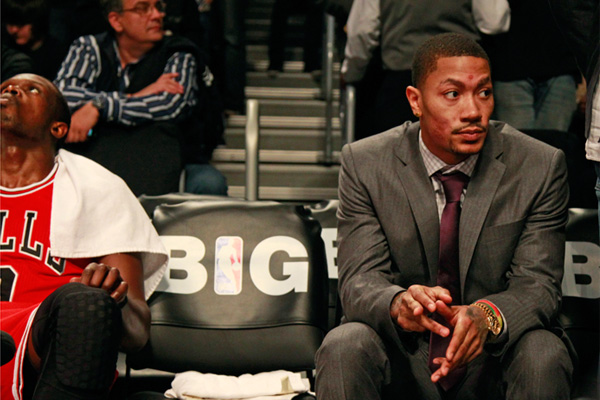
Nuccio DiNuzzo / Chicago Tribune
Derrick Rose on the bench in Game 1 in Brooklyn.
After a wretched performance in the opener on Saturday, the Bulls have taken control of its opening round playoff series against Brooklyn, winning two straight. They've mitigated, at least for now, the Nets’ home court advantage.
Not surprisingly, Tom Thibodeau’s crew has done it on the defensive end, swarming the strong-side of a Brooklyn offense that has scored with solid efficiency most of the year, especially in the half-court. Zach Lowe thinks Monday night’s road victory, cued in the fourth quarter by an ailing Joakim Noah, “might have been the single most inspiring performance any team has put on this season.”
If this bench reaction is any indication, he may be right:

gif: courtesy sb nation
Carlos Boozer, as expected, has played well in the post, scoring 13 and grabbing 12 rebounds in Game 2 (even as the Nets consistently fronted and then doubled-teamed him) and pouring in 22 and 16 last night. But he’s been just about the only bright spot for Chicago’s offense, which failed to knock down a single field goal in the final half of the fourth quarter Thursday, almost letting a comfortable lead slip away.
The Derrick Rose will-he-or-won’t-he saga hit a fever pitch this week, and understandably so; the Bulls (26th in points-per-possession, down nine slots from the year prior) have struggled to score the basketball for months, and there’s no reason to think they’ll improve unless the 2011 MVP suits up.
To be frank, it looks unlikely, and has for some time. (I generally agree with the “give him some space” argument, best delivered by Kelly Dwyer, the Internet’s most insightful Bulls writer.) But it’s Friday, so why don’t we let our imaginations run wild.
If Rose did decide to rejoin the team, what type of production could we expect from him?
When he’s healthy, few in the league (and nobody on the Bulls) can make plays like Rose. Of high-usage players, only Chris Paul is anywhere near as efficient with the ball in his hands on pick-and-rolls, the NBA’s most common play. Jumping back into the playoff rotation after a long hiatus, however, is something only a handful of players have ever done. Chris Herring, the Wall Street Journal's Knicks’ reporter, recently ran the numbers for those who have:
Just five players over the past 20 years have rejoined their team in the second round of the playoffs or later after missing two months of time or more due to injury, according to Stats LLC. And each player—including Miami's Udonis Haslem in 2010-11; Orlando's Jameer Nelson in 2008-09; Phoenix's Kurt Thomas in 2005-06 and the Lakers' Ron Harper in 2000-01—experienced double-digit decreases in their shooting-percentage or incredibly reduced playing time.
The one other player who missed considerable time before making a late postseason comeback: The Knicks' Patrick Ewing in 1997-98. And oddly enough, that year's team met a top-five defense, the Indiana Pacers, in the second round. The then-35-year-old, who returned after dislocating a bone in his right wrist, averaged just 14 points on 35.7% shooting for the series, which the Knicks dropped.
So, not so encouraging.
But Herring, writing about the Knicks’ Ivan Shumpert (an Oak Park native) in February, has also investigated how players respond to ACL injuries specifically. Without the ability to move properly, those with torn knees tend to focus on shooting form, and with impressive returns:
To find out, the Journal looked at 34 NBA players who have torn an ACL since 2003. To factor out the effects of age, we limited the sample to the 20 players who were 26 years or younger at the time of the injury. Since coming back, those players have shot 42% from 16 to 23 feet—up from 38% before their injuries, a fairly significant improvement.
That statistic looks even more persuasive when you consider that for players in that age range who have spent at least five years in the NBA and did not sustain an ACL injury—midrange shooting actually declined to 39% in their most recent season from 40% when they were rookies, according to Stats LLC.
So, more encouraging!
Even before the ACL blowout, Rose—suffering several nagging injuries—missed significant time last season; on three separate occasions, he sat out longer than 10 days between starts. I checked the game logs, and Rose played fairly well in all three “return” games, though not exceptionally so. On January 23, coming off a sprained toe, he scored 22 and dished out eight assists against the Nets. A month later, facing Atlanta on February 20, he tossed in 23 on 18 shots and recorded six rebounds and five dimes. And in New York on April 8, fighting through a sore groin, he shot miserably and turned it over eight times, but still managed 29 points.
So, inconclusive!
To round out our experiment, I combed through Derrick’s career numbers against the villainous Heat, who the Bulls would play in the second round should they knock off Brooklyn. In 10 games since Lebron James took his talents to South Beach, including five in the 2011 Eastern Conference Finals, Rose has shot just 37 percent from the floor (87/235) while sporting a reasonable 2:1 assist-to-turnover ratio.
Would a Rose return help? Absolutely. How much? Who the hell knows.


